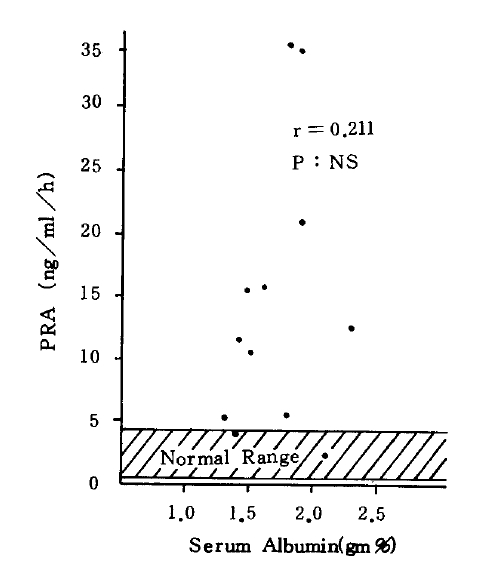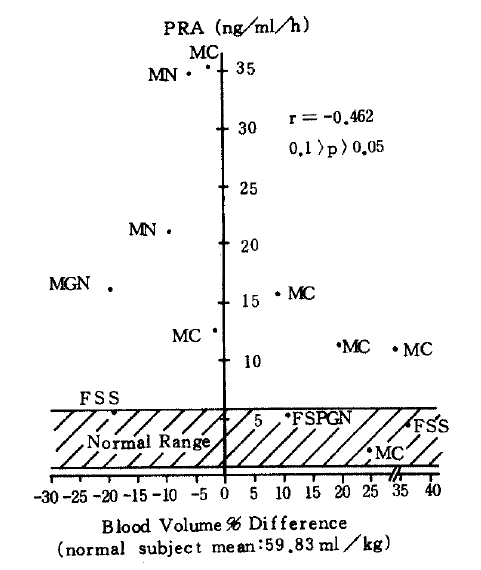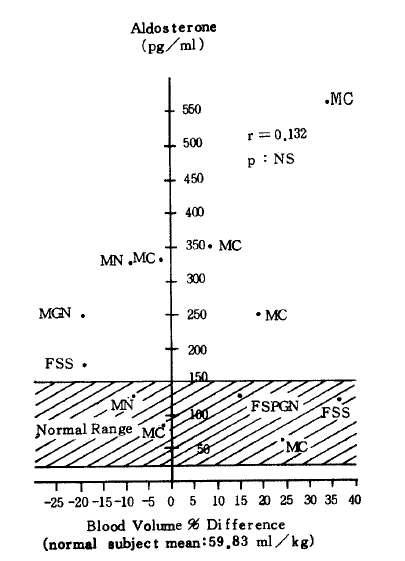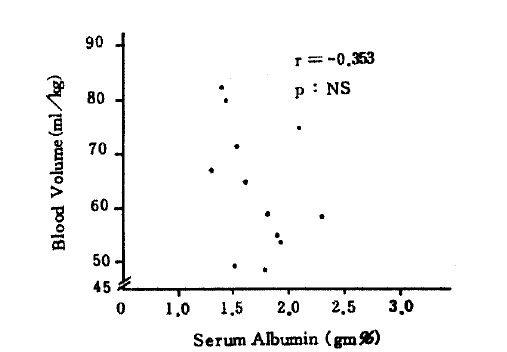A Study of the Renin-Angiotensin System and the Blood Volume in the Nephrotic Syndrome
Article information
Abstract
The plasma renin activity (PRA), plasma aldosterone level, and blood volume were studied in 12 patients with idiopathic nephrotic syndrome. As a whole, the patients with the nephrotic syndrome showed significant elevations of the PRA and plasma aldosterone but not in blood volume compared to the normal controls. Six patients who had a larger blood volume than the control group had decreased PRA, while the other 6 patients who had a smaller blood volume than the control group had an increased PRA. Also noted was that there was no histopathological difference of kidney diseases between the patients with increased blood volume and decreased blood volume. Though there was no correlation between serum albumin, PRA, and plasma aldosterone levels, there was a tendency of increased blood volume as serum albumin decreased.
INTRODUCTION
It is generally recognized that the sodium retention in patients with nephrotic syndrome is due to an imbalance of the “Starling” forces that determine fluid exchange across capillary membranes. Hypoalbuminemia in the nephrotic syndrome results in decreased plasma oncotic pressure and enhances filtration of fluid into the interstitium and the third spaces. The resultant intravascular volume depletion stimulates renal sodium reabsorption by mechanisms thought to include decreased glomerular filtration, increased tubular sodium reabsorption, and increased activity of the renin-angiotensin-aldosterone system.1–3) But other studies, however, have indicated that not all patients have high renin or aldosterone values4–7) and studies of blood volume have yielded conflicting results.8,9)
Meltzer et al.4) divided that patients with nephrotic syndrome into two different pathophysiologic forms. One group with vasoconstriction or hypovolemic nephrosis (classic form) had high renin and aldosterone levels and had minimal lesion disease. The other group with hypervolemic or overfilling nephrosis (overfilling form) had low renin and aldosterone values, frequent hypertension, mild renal insufficiency, hypervolemia, and steroid resistance. In the latter, the plasma volume was increased due to impaired renal sodium excretion. Therefore it might be possible to distinguish which of these two mechanisms is predominent in individual patients with nephrotic syndrome by measuring blood volume, plasma renin activity, and plasma aldosterone simultaneously. The present study was carried out to determine plasma renin activity, plasma aldoesterone and blood volume in patients with nephrotic syndrome, and compared these parameters with pathological findings of renal biopsy.
PATIENTS AND METHODS
Twelve patients with idiopathic nephrotic syndrome were studied from May, 1983 to September, 1983. None of the patients had secondary nephrotic syndrome, or any evidence of active systemic disease on diagnostic work-up, or any previous therapy for nephrotic syndrome. They had normal cardiac, endocrine, and hepatic function. All of the patients were edematous, excreted more than 3.5 gm protein daily and had plasma albumin of less than 2.5 gm/dl. None of the patients were on diuretics, steroids, or immunosuppressive drugs during the early admission periods. They were placed on a low sodium diet (NaCl 6 gm daily). Twelve control patients were chosen among the patients who had no hypertension, renal disease, or any other disease which could cause edema and changes in plasma renin activity and aldosterone.
Peripheral venous blood was taken in the morning while the patients were quietly seated for one hour. Plasma renin activity (PRA) and plasma aldosterone were measured by using [125I] plasma renin activity kit (Travenol Laboratory) and aldosterone radioimmunoassay kit (Cea Sorin).
Blood volume was measured by the method of Sterling and Gray10) using 51Cr-tagged RBC, and plasma volume was then calculated indirectly from blood volume and hematocrit. Blood volume was expressed as ml/kg of edema free body weight.
RESULTS
The age of the 12 patients with idiopathic nephrotic syndrome was 12 to 60 years, 9 males and 3 females. Six patients had membranous nephropathy, 2 patients focal segmental sclerosis, 1 patient focal segmental proliferative glomerulonephritis, and 1 patient mesangeal proliferative glomerulonephritis on renal biopsy. All patients had proteinuria, ranging from 3.5 to 24.0 gm/24 h (mean 9.18 gm/24 h). Serum albumin was higher than 2 gm/dl in 2 patients and lower than 2 gm/dl in 10 patients. Serum creatinine was 5.6 mg/dl in 1 patient, 2.5 to 3.4 mg/dl in 3 patients, and less than 2 mg/dl in 8 patients. PRA value was 2.4 to 34.7 ng/ml/h and plasma aldosterone value was 64 to 350 pg/ml. The lowest total blood volume was 54.6 ml/kg, and the highest was 81.3 ml/kg. (Table 1).
PRA, aldoesterone and blood volume were measured in control patients and patients with nephrotic syndrome with edema. The mean value of PRA of patients with nephrotic syndrome was significantly higher than that of control group (14.84 ± 3.15 vs. 2.11 ± 0.54 ng/ml/h, p<0.005), and the mean value of plasma aldosterone of patients with nephrotic syndrome with edema was also significantly higher than that of the control group (231.4 ± 41.5 vs. 91.4 ± 11.7 pg/ml, p<0.05). Mean total blood volume and mean plasma volume of the patient group were 63.43 ± 3.30 ml/kg and 42.72 ± 2.17 ml/kg, respectively, and those of the control group were 59.83 ± 4.60 ml/kg and 41.33 ± 3.99 ml/kg respectively. The values of total blood volume and plasma volume were slightly increased in the patient group, but not significantly (Table 2).
Ten of twelve patients with nephrotic syndrome had elevated PRA and 2 had a normal PRA compared to that of the control group. In the relationship between serum albumin and RPA of 12 patients, plasma renin activity had a wide range of distribution and no significant correlation between plasma aldosterone and serum albumin (r= −0.135) (Fig. 1 and 2).
Total blood volume expressed as the percentage of the mean of control group (59.83 ml/kg) showed that 6 patients had an increased blood volume and the other 6 patients had a decreased blood volume. Three of the six patients with decreased blood volume had a normal PRA. Although PRA tended to decrease in those patients with decreased blood volume, there was no significant correlation between PRA and blood volume (r= −0.462, 0.1>p>0.05). Also no histopathological difference of renal disease was found between the patients with increased blood volume and those with decreased blood volume. Excluding 1 case, plasma aldosterone level tended to decrease in patients with an increased blood volume and tended to increase in patients with decreaed blood volume but the correlation was not significant. (Fig. 3 and 4). Although there was no significant correlation between serum albumin and total blood volume (r= −0.353), the total blood volume had a tendency to increase as serum albumin decreased (Fig. 5).
DISCUSSION
Many researches have been tried in order to clarify mechanisms for sodium retention in the patients with nephrotic syndrome but still they have not seen clearly identified. Two possible mechanisms are proposed. One is that the urinary protein loss leads to a reduction in plasma albumin causing decreased serum oncotic pressure and a reduced blood volume, which stimulates renin and increased secretion of aldosterone, and results in compensatory renal sodium and water retention.1–3) The other mechanism is that the nephrotic kidney itself may fail to excrete sodium normally, and hence sodium retention results. This latter mechanism for sodium retention would cause an increase in blood volume and suppression of the renin-angiotensin-aldosterone system.4,5,9) Also, as the natural course of the idiopathic nephrotic syndrome shows exacerbation and remission, the relation between plasma volume, PRA, and aldosterone could be variable according to the time of examination even in the same patient. These observation may be the possible causes for the variable results of several previous reports.4,5) Our results showed that 6 patients with a decreased blood volume tended to have higher PRA when compared to the 6 patients with an increased blood volume and it was in agreement with the classic theory that the edema is formed in response to the reduced blood volume which stimulates renin-angiotensin-aldosterone system. But the relation of plasma aldoesterone and blood volume in our results was even less obvious as compared to that of blood volume and the PRA.
Meltzer et al.4) reported that nephrotic patients with minimal change glomerulonephritis had low blood volume and increased PRA and aldoesterone, but in our results there was no notable relation between histopathological findings and blood volume, PRA or aldosterone. This observation was in accordance with the results of Brown et al.5)
Dorhout Mees et al.9) observed that in nephrotic patients with minimal change glomerulonephritis, the blood volume was slightly or notably increased and PRA was low or normal in all these patients. Then, they contradicted the classic theory that the secondary hyperaldosteronism by reduced blood volume seemed to play a major role in the formation of edema in nephrotic syndrome. And they insisted that probably some other factors such as disturbance of glomerular filtration played important role in formation of edema. There is experimental evidence that in nephrotic syndrome and intrarenal disturbances cause increase in sodium reabsorption. Ichikawa et al.11) using rat where one kidney had been perfused with aminonucleoside, demonstrated that the perfused kidney leaked protein and had increased sodium reabsorption, whilst the non-perfused kidney excreted sodium normally. Chonko et al.12) measured PRA and aldosterone in the patients with salt loading after excessive sodium intake for 5 days, observed that in 10 patients with the nephrotic syndrome, 8 maintained elevated PRA and aldosterone levels but two retained similar amounts of sodium with suppression on PRA and aldosterone. There was no relation between the response of PRA and aldosterone to sodium intake and sodium retention, glomerular filtration rate or serum concentration. Therefore, they concluded that other unidentified factors other than glomerular filtration or aldosterone could be involved in the edema formation of these patients. In patients with nephrotic syndrome, to keep sodium balanced, the possible role of natriuretic hormone was frequently suggested and more recently the effects of prostaglandin were proposed. The latter usually increased the activity of renin-angiotensin-aldosterone system in nephrotic state, congestive heart failure and liver cirrhosis, and enhanced renal sodium excretion to keep normal homeostasis.13)
Many different results were reported according to the investigators concerning the relation between serum albumin and blood volume in patients with nephrotic syndrome. Garmett et al3) reported that blood volume was found to be normal or reduced in the patients with nephrotic syndrome. Eisenberg8) measured blood volume in 15 patients with nephrotic syndrome by 51Cr-tagged RBC method. Blood volume was within normal range in 10 patients, elevated in 3 patients, and decreased in 2 patients. And the blood volume measured after the disappearance of the edema was increased in some cases and reduced in others so no clear relation could be observed between before and after remission of edema. It was generally recognized that hypoalbuminemia played a major role in the formation of edema in nephrotic syndrome, and the concentration of serum albumin tended to correlated inversely with the degree of edema.14) But our results showed that the blood volume tended to increase as the serum albumin decreased. Some investigators reported that the blood volume could be increased in the state of decreased plasma oncotic pressure. Rusznyak et al.15) suggested that although a decreased plasma oncotic pressure could be found in the patients with nephrotic syndrome, should the capillary hydrostatic pressure decreased simultaneously, the blood volume might not be decreased. Wraight.16) using rats treated with plasmapheresis, found that the serum albumin decreased by 35 percent and blood volume increased by 16 percent in spite of slight decrease of total extracellular volume.
For the mechanisms of maintaining normal or increased blood volume in spite of decreased serum albumin in patients with nephrotic syndrome, Rusznyak et al. suggested that increased lymphatic flow replenished the circulating blood volume.15) But Wraight16) explained these phenomena by the change of capillary permeability to protein. Hypoalbuminemia altered capillary permability to protein and resulted in a decrease of concentration of interstitial protein. Accordingly, in spite of decreased plasma oncotic pressure, osmotic pressure gradient could be maintained or rather increased. When these results are applied to clinical manifestation of nephrotic syndrome, in the early stage of nephrotic syndrome, hypoalbuminemia results in contraction of plasma volume and activation of renin-angiotension-aldosterone system, so that oliguria, orthostatic hypotension, and refractoriness to diuretic treatment could be noticed. But in the later stage when the disease reveals a chronic course, plasma volume could be maintained or increased by the mechanisms of increased lymphatic flow, change in capillary permeability to protein, and other unidentified factors, and hypertension could develop in that circumstance.
In summary, secondary hyperaldosteronism seemed to play a major role in the retention of sodium in some patients with nephrotic syndrome. However, in patients with normal PRA and aldosterone level, unidentified factors other than secondary hyperaldosteronism might contribute to sodium and water retention. No relation was noted between renin-angiotensin-aldosterone activity and renal histopathological findings.






